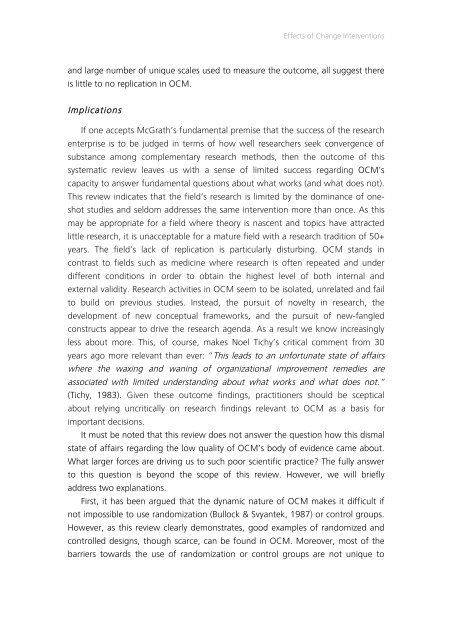In Search of Evidence
jqluvth
jqluvth
Create successful ePaper yourself
Turn your PDF publications into a flip-book with our unique Google optimized e-Paper software.
Effects <strong>of</strong> Change <strong>In</strong>terventions<br />
and large number <strong>of</strong> unique scales used to measure the outcome, all suggest there<br />
is little to no replication in OCM.<br />
Implications<br />
If one accepts McGrath’s fundamental premise that the success <strong>of</strong> the research<br />
enterprise is to be judged in terms <strong>of</strong> how well researchers seek convergence <strong>of</strong><br />
substance among complementary research methods, then the outcome <strong>of</strong> this<br />
systematic review leaves us with a sense <strong>of</strong> limited success regarding OCM’s<br />
capacity to answer fundamental questions about what works (and what does not).<br />
This review indicates that the field’s research is limited by the dominance <strong>of</strong> oneshot<br />
studies and seldom addresses the same intervention more than once. As this<br />
may be appropriate for a field where theory is nascent and topics have attracted<br />
little research, it is unacceptable for a mature field with a research tradition <strong>of</strong> 50+<br />
years. The field’s lack <strong>of</strong> replication is particularly disturbing. OCM stands in<br />
contrast to fields such as medicine where research is <strong>of</strong>ten repeated and under<br />
different conditions in order to obtain the highest level <strong>of</strong> both internal and<br />
external validity. Research activities in OCM seem to be isolated, unrelated and fail<br />
to build on previous studies. <strong>In</strong>stead, the pursuit <strong>of</strong> novelty in research, the<br />
development <strong>of</strong> new conceptual frameworks, and the pursuit <strong>of</strong> new-fangled<br />
constructs appear to drive the research agenda. As a result we know increasingly<br />
less about more. This, <strong>of</strong> course, makes Noel Tichy’s critical comment from 30<br />
years ago more relevant than ever: “This leads to an unfortunate state <strong>of</strong> affairs<br />
where the waxing and waning <strong>of</strong> organizational improvement remedies are<br />
associated with limited understanding about what works and what does not.”<br />
(Tichy, 1983). Given these outcome findings, practitioners should be sceptical<br />
about relying uncritically on research findings relevant to OCM as a basis for<br />
important decisions.<br />
It must be noted that this review does not answer the question how this dismal<br />
state <strong>of</strong> affairs regarding the low quality <strong>of</strong> OCM’s body <strong>of</strong> evidence came about.<br />
What larger forces are driving us to such poor scientific practice? The fully answer<br />
to this question is beyond the scope <strong>of</strong> this review. However, we will briefly<br />
address two explanations.<br />
First, it has been argued that the dynamic nature <strong>of</strong> OCM makes it difficult if<br />
not impossible to use randomization (Bullock & Svyantek, 1987) or control groups.<br />
However, as this review clearly demonstrates, good examples <strong>of</strong> randomized and<br />
controlled designs, though scarce, can be found in OCM. Moreover, most <strong>of</strong> the<br />
barriers towards the use <strong>of</strong> randomization or control groups are not unique to


